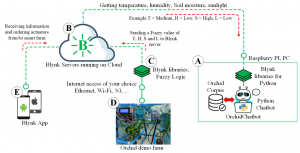Unfathomable as it may seem, a smartphone is all you will need to text your plant. All you need to do is to open a chatbot, type in your message, and hit send. Your plant will then reply to your question just like one of your friends would. Researchers have been experimenting with the idea of texting such mute living things for years and have recently concocted a concoction that does just that.
Based on IoT (Internet of Things) and Fuzzy Logic, an automatic smart farming system with a chatbot interface was created. Through an eight-week trial, researchers were able to successfully converse with orchids to find out what it needs during their growth and consequently tweak their living conditions based on their responses.
Why is this significant, you may ask?
Well, the reality is that plants are unable to thrive in all conditions – at least at the current moment – which is not a good outlook considering that we consume a wide variety of plants. Therefore, this research and breakthroughs are pivotal for farmers to boost growth rates and yields. You might then find it rather ironic that orchids grown normally have a higher average growth rate as compared to those in the automated smart farming. However, automated smart farming yielded a more consistent growth rate and a higher end yield – which are more favourable for farmers.
However, the core question of how to text a plant remains unanswered up till now.
Just like a language translation service that helps interpret one language into another language that one can comprehend, the automatic smart farming system translates the answers from the plants in response to the questions from humans. For example, if you ask a plant in this smart farming system “How are you?”, the answer of the (plant) chatbot can be “I am cold” or “I am feeling hot” depending on the temperature, the humidity and the soil moisture where the plant is. To achieve this human-plant chatting, the system uses Natural Language Understanding (NLU), Natural Language Processing (NLP), and pattern matching to analyse the user’s questions and return the response to the user. Figure 1 depicts this workflow.

Figure 1: Chatbot’s workflow
The replies from the chatbot reflect the plant’s needs based on existing environmental information. The smart farming systems contain sensors that measure the temperature, humidity, soil moisture, and sunlight from the server. These measurements are mapped to human-liked responses using Fuzzy logic, such as “I am cold” in the above example. Figure 2 shows the working process of chatbot in the Orchid demo farm where the automatic smart farming system was deployed.

Figure 2: The working process of chatbot in Orchid demo farm
The performance evaluation of the Orchid demo farm yields satisfactory results – with the average accuracy of conversation between chatbot and orchids being 0.71 in harmonic mean, 0.75 in precision, and 0.6 in recall. Chatting with orchids would help farmers to understand the plant condition and timely respond to their needs for better growth in the long-term while reducing fertilizer and preventing giving excessive water to the plants.
Therefore, imagining a day when we can text back and forth with our plants isn’t very unrealistic – it’s just a matter of time.
Wiangsamut, Samruan & Chomphuwiset, Phatthanaphong & Khummanee, Suchart. (2019). Chatting with Plants (Orchids) in Automated Smart Farming using IoT, Fuzzy Logic and Chatbot. Advances in Science, Technology and Engineering Systems Journal. 4. 10.25046/aj040522.
Author: Yee Hui Min

Hui Min – this is so bizarre and cool! I really, really wish I had this for my own plants at home 🙂
-Edie